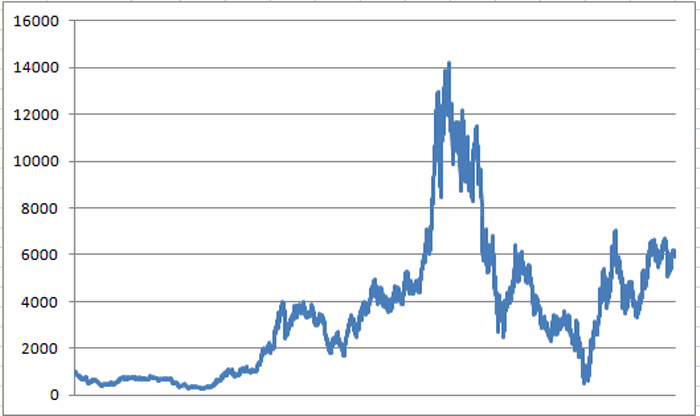No, we’re not talking resale value here (in which case losing 95% of your original investment is a distinct possibility). We are talking about stock ownership. In a nutshell, the answer is fairly simple:
*It is OK to drive a Ford in late summer into fall. But it is NOT OK (apparently) to own Ford stock during late summer into fall.
The History
In Figure 1 you see the growth of $1,000 invested in Ford stock on a buy-and-hold basis since January 1, 1973 (“When a Ford and a Chevy would still last 10 years like they should”; a spontaneous Merle Haggard Moment. Sorry.) Figure 1 – Growth of $1,000 invested in Ford buy-and-hold since 1/2/73
Figure 1 – Growth of $1,000 invested in Ford buy-and-hold since 1/2/73
As you can see, there were a few, um, ups and downs along the way.
But now let’s – please forgive me for this one, but you didn’t really expect me to pass it up did you….
Take a Look Under the Hood
For reasons that I wish I could explain – and yes, there is a part of me that wants to weave some BS explanation, but alas, nothing particularly plausible comes to mind – the three-month period comprised of August, September and October have been – for lack of a better phrase – a “wreck on the side of the road.”
The Summary numbers appear in Figure 2. 
Figure 2 – Ford performance during July 31st through October 31st every year since 1973
As you can see in Figure 2, this 3-month period has seen Ford decline 63% of the time. And the average loss was 1.36 times the average gain. Clearly not good numbers, but when presented in this form one may come away thinking “bad, but not terrible”.
Wrong, carburetor breath!
A Picture is Worth, Um, A Thousand Miles (?)
In Figure 3 we see the cumulative performance of $1,000 invested in Ford stock only during the months of August, September and October starting in 1973.
Even a crash test dummy wouldn’t be willing to ride this one out. Figure 3 – Growth of $1,000 invested in Ford stock only during August, September and October (1973-2014)
Figure 3 – Growth of $1,000 invested in Ford stock only during August, September and October (1973-2014)
For the record, $1,000 invested in Ford stock only during the months of August through October since 1973 has declined to just $45 (or -95.5%). Even a set of tailfins isn’t going to make this look any better.
The Net Effect
For our final “road test” (someone, please make me stop) we will consider the plight of Investor A and Investor B.
Investor A: Holds Ford stock 9 months out of every year, but is out of Ford stock during August, September and October every year.
Investor B: Is a buy-and-hold Ford stock investor (no truth to the rumor that one is born every minute).
The comparative results appear in Figure 4.
 Figure 4 – Growth of $1,000 in Ford stock since 1/2/1973; Red line = Buy and Hold; Blue line = long Ford stock all months EXCEPT August, September and October
Figure 4 – Growth of $1,000 in Ford stock since 1/2/1973; Red line = Buy and Hold; Blue line = long Ford stock all months EXCEPT August, September and October
For the record:
Investor B – the buy and hold investor – has seen has seen his original $1,000 investment grow to $5,906 (or +490%).
Investor A – out the same three months every year – has seen his original $1,000 investment grow to $131,433 (or +13,043%).
Investor A gained roughly 26.5 times the profit of Investor B. Talk about a “Performance Vehicle”……
Summary
So is this “strategy” guaranteed to be a winner going forward? Not necessarily. Heck, if history is a guide then there is a 37% chance that Ford will show a gain during August through October of 2015.
Still, while your results may vary, historically Ford stocks “mileage” during August through October has [insert your bad auto related pun here, I’m all out].
Jay Kaeppel


I think you may have exceeded your pun quota for the month, and it’s only the 27th!
I wonder if this seasonality is true for the car companies in general? There could be some argument that investors get twitchy before the new season’s cars are released, and then feel more confident once that happens.
I took a quick look at Toyota and the stock is rangebound or downright falling during the last four years or so during the period you specify. And it seems to do best between October-March for three of those four years. Is that a significant sample size? Of course not! But it looks interesting. Perhaps an automotive ETF could show some seasonal component but smooth out the bumps….